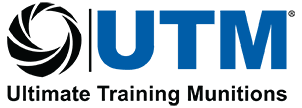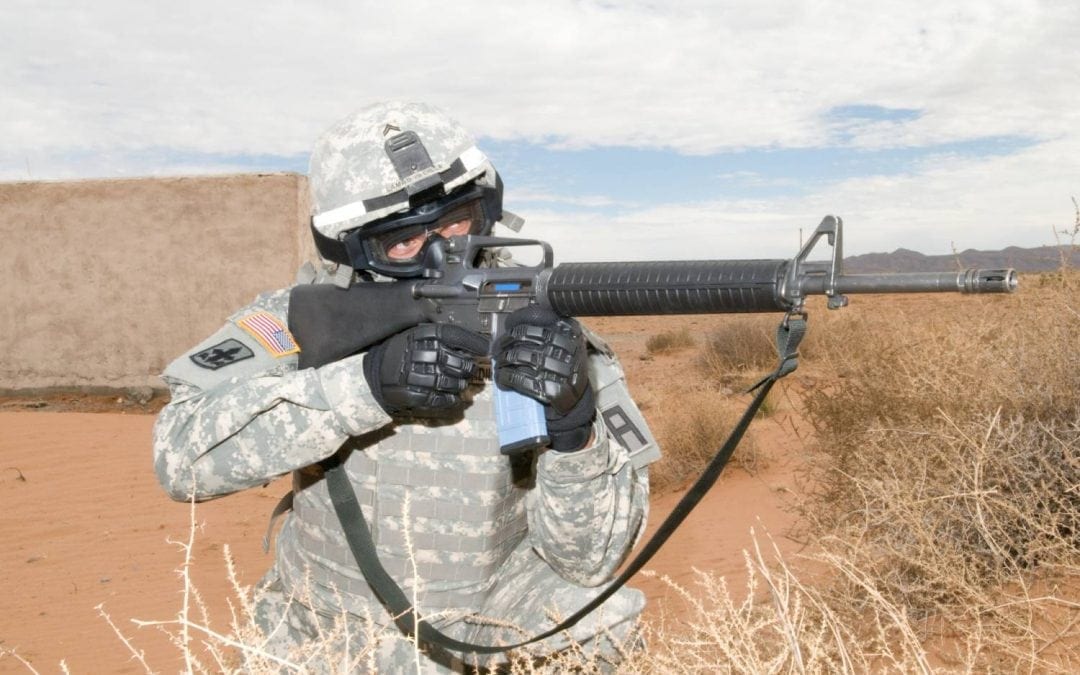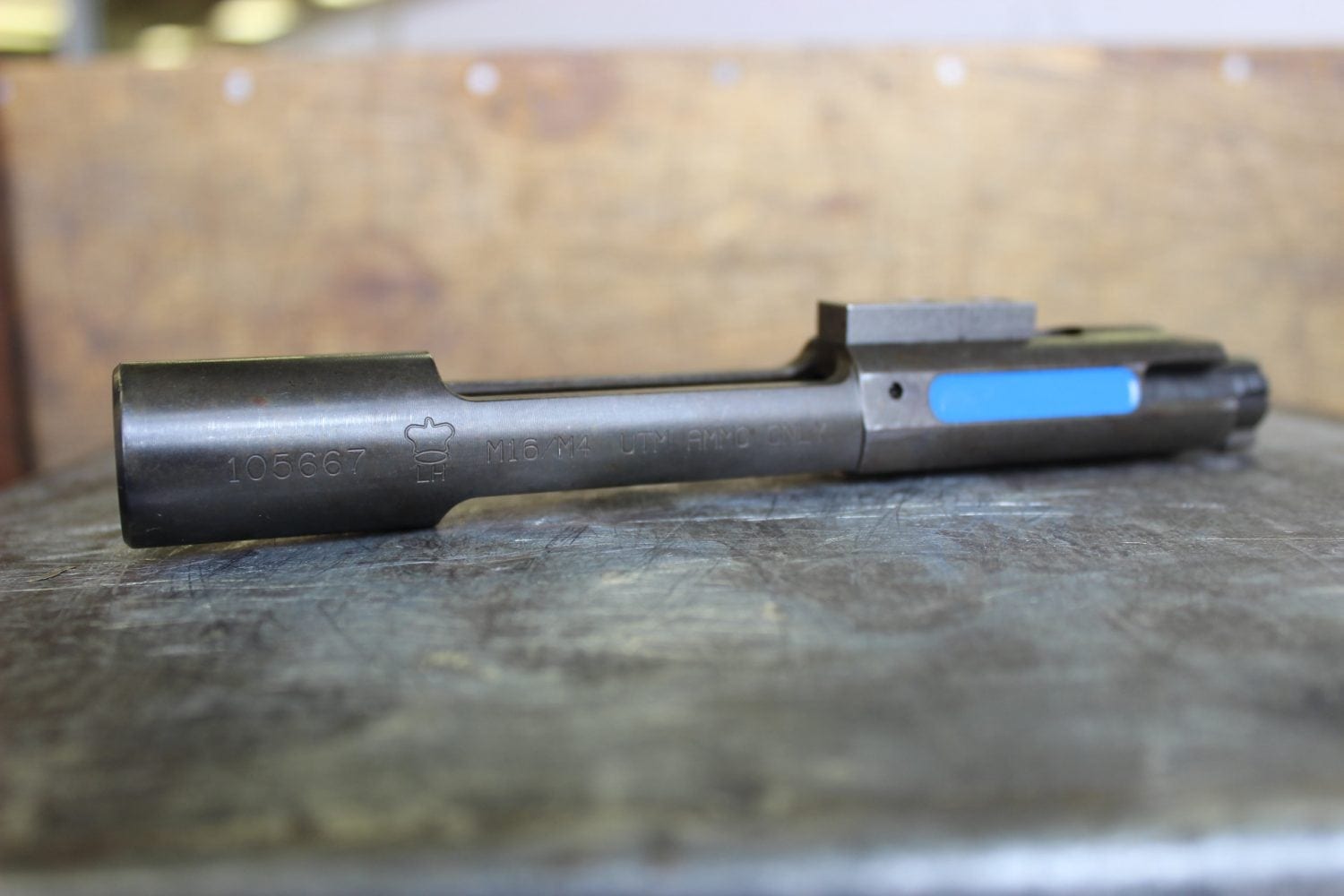Over the last 3 years we have completed hundreds of UTM certification courses in over 50 U.S. Military bases worldwide.
We have conducted numerous NLTA Instructor Courses, Active Shooter Instructor Courses, Tactics Instructor Courses, CQB Instructor Courses and Tactical Rifle Instructor Courses at various bases and schools throughout the U.S. Army and U.S. Air Force.
CLOSE COMBAT MISSION CAPABILITY KIT (CCMCK)
Ultimate Training Munitions Reality Based Training (UTM) has continuously held and currently holds the U.S. Army Close Combat Mission Capability Kit (CCMCK) contract since it was awarded in 2008. The U.S. Army has been fielding the standardized CCMCK that enhances Soldier, leader and unit prep-for-combat training in the close fight. When struck by CCMCK (UTM) projectiles in a less protected (legs/arms) location, Soldiers experience a “pain-penalty” for mistakes such as failing to use suppressive fire, cover, concealment, and proper individual movement techniques (IMTs). The Army’s standard CCMCK has been in place at Training Support Centers (TSCs), but individual units may procure their own CCMCK kits through GSA or be requisitioned via CTA 50-970 Expendable/Durable items and maintained at the unit level and documented on unit property books.
CCMCK applies to the Active Army, Army National Guard (ARNG)/National Guard of the United States (ARNGUS), and the US Army Reserve (USAR) unless otherwise stated. It applies to Active Army, ARNG, ARNGUS and USAR, it also applies to all mission and support MOS’s.
COMPONENTS OF CCMCK
The CCMCK system allows Soldiers to temporarily convert their standard issued weapons with “drop-in” conversion bolts for UTM M4/M16s and M249s. Converted weapons allow for normal weapon employment functioning, for example, aiming (with or without mounted optics/ accessories), loading, firing, ejection, immediate action, re-loading and clearing procedures. Soldiers can utilize CCMCK throughout the training cycle beginning with the fundamentals of marksmanship and continuing through tactical applications to include all unit tactics, techniques and procedures (TTP) within force on target, force-on-force, interactive live-fire scenario tasks, and mission execution rehearsals.
The Army’s standard CCMCK provides a dynamic addition to realism and training with the fighting tools in the warfighter’s toolbox. The CCMCK improves individual and collective task performance regarding the development, refinement, and fighting skills needed in the execution of tactics, techniques and procedures (TTPs) and SOPs.
CCMCK RELATED TACTICS, TECHNIQUES AND PROCEDURES (TTP)
Below are the supporting field manuals, training publications, training circulars and technical manuals.
FIELD MANUALS
• FM 3-06 Urban Operations. 26 October 2006.
• FM 3-06.11 Combined Arms Operations in Urban Terrain. 28 February 2002. FM 3-20.12 Tank Gunnery (Abrams). 15 August 2005.
• FM 3-21.8 (FM 7-8) The Infantry Platoon and Squad. 28 March 2007.
• FM 3-21.9 SBCT Infantry Rifle Platoon and Squad. 2 December 2002. FM 3-21.10 The Infantry Rifle Company. 27 July 2006.
• FM 3-21.11 The SBCT Infantry Rifle Company. 23 January 2003. FM 3-21.20 The Infantry Battalion. 13 December 2006.
• FM 3-21.21 The Stryker Brigade Combat Team Infantry Battalion. 8 April 2003. FM 3-21.71 Mechanized Infantry Platoon and Squad (Bradley). 20 August 2002. FM 3-22.9 (FM 23-9) Rifle Marksmanship M16A1, M16A2/3, M16A4, and M4 Carbine. 24 April 2003.
• FM 7-0 Training the Force. 22 October 2002.
• FM 7-1 Battle Focused Training. 15 September 2003.
• FM 25-4 How to Conduct Training Exercises. 10 September 1984.
SOLDIER TRAINING PUBLICATIONS
• STP 21-1-SMCT Soldier’s Manual of Common Tasks Skill Level 1. 14 December 2007.
• STP 21-24-SMCT Soldier’s Manual of Common Tasks (SMCT) Warrior Leader Skill Levels 2-4. 2 October 2006.
TRAINING CIRCULAR
• TC 7-98-1 Stability and Support OperaVons Training Support Package. 5 June 1997.
• TC 90-1 Training for Urban OperaVons. 19 May 2008
TECHNICAL MANUAL
• TM 9-6920-3700-10, Close Combat Mission Capability Kit (CCMCK). 13 March 2009.
PAMPHLET
• DA PAM 350-38, Standards in Weapons Training. 3 July 1997.
WARRIOR TASKS
• Qualify with assigned weapon
• Correct malfunctions with assigned weapon
• Engage targets with M240B MG (Familiatization of Weapon System, Load, Unload, Engage targets, and Maintaining Weapon System)
• Engage targets with M60 or M249 MG (Familiarization of Weapon System, Load, Unload, Engage targets, and Maintaining Weapon System)
• Correct malfunctions of a MG (M240B, M249)
• Engage targets using an aiming light (AN/PEQ-2A, AN/PAQ-4)
• Perform movement techniques during an urban operation
• Engage targets during an urban operation
• Enter a building during an urban operation
• Move over, through, or around obstacles (Except Minefields)
• Move under direct fire
• React to direct fire (Dismounted and Mounted)
• React to man-to-man contact (Combatives)
• Maintain equipment
• Evaluate a casualty (care under fire)
• Perform first aid for open wound (abdominal, Chest & head)
• Perform first aid for bleeding of extremity
• Select temporary fighting position
CCMCK TRAINING PHASES
CCMCK is recommended to be utilized within the three training phases. The three training phases are initial, intermediate, and culminating. Each of these includes some live and constructive environments that are used to train a multitude of tasks that CCMCK will enhance. Many individual specific tasks and some collective tasks can be taught and practiced in garrison while most collective tasks are best conducted at local training areas, installation facilities and weapons ranges. The live training environment consists of home station training using the Urban Assault Course (UAC), Shoot House (SH), Breach Facility (BF), Combined Arms Collective Training Facility (CACTF), Combat Training Center (CTC) rotations, and any other live training that supports the training. It should be pointed out though that CCMCK is not range dependent because it is classified as “force on force” training ammunition.
CCMCK INITIAL PHASE
This phase, which trains individual and collective tasks, is the first step in the building-block approach. It forms the basis of unit or collective training. The tasks train basic marksmanship skills and other Soldier tasks needed to perform any tactical operation including training in a live environment with CCMCK.
CCMCK INTERMEDIATE PHASE
This phase of training is characterized by collective task training in varied conditions such as limited visibility; different entry techniques and points; incorporation of noncombatants and OPFOR; use of MILES, CCMCK; and live-fire exercises. It is the vital link between individual tasks and mission accomplishment.
CCMCK CULMINATING PHASE
This is the phase of training that pulls all the TTPs together. For example, if conducting Urban Operations, the Combined Arms Collective Training Facility (CACTF) is where the culminating phase of urban operations training ends. This phase can include multi-echelon, combined arms, and branch specific STX training utilizing CCMCK or blanks.
CCMCK CONDUCT OF TRAINING
Depending on unit proficiency and realistic time requirements for each task, every training event should follow a crawl-walk-run sequence, based on clearly defined task, conditions, and standards. This training methodology may be arranged in any order as long as it builds from simple to complex task and techniques as follows:
- Identify the unit’s critical missions (see commander’s training guidance) and select those tasks that support specific METL related to urban operations.
- Arrange the related tasks in the order of their importance to mission accomplishment.
- Assess the unit’s current level of proficiency (strengths and weaknesses) and determine the degree of difficulty of each task. The training events should start from the less difficult tasks to the more difficult tasks. This instills confidence in the Soldiers conducting the training.
- Identify the individual and leader tasks that are to be trained.
- Set up training conditions based on unit proficiency.
CRAWL
The trainer explains each training objective and performance standards, and then talks the Soldiers through the exercise, step by step, describing what each individual or unit must do. This training often includes demonstrations, basic skills training and force on target. CCMCK may be used to validate individual and unit skills while enhancing realism.
WALK
The Soldiers practice each task to standard. Trainers coach Soldiers at this stage correct mistakes if needed and providing feedback. Soldiers practice each task repeatedly until they can perform it to standard. This training includes the progression from the “Crawl” methodologies and may utilize force on role player (OPFOR) CCMCK may be used to validate skills, tactics and protocol while enhancing realism.
RUN
Soldiers perform each task at full speed as if they are in combat. The Soldiers need feedback during this stage as well. This training includes the methodology progression from “Crawl” and “Walk” and incorporates force on target, force on force and scenario training. CCMCK may be used to validate skills, tactics and SOPs while enhancing realism.
CCMCK DEMONSTRATIONS
Trainers must demonstrate the correct way to perform the tasks that the Soldiers will be required to perform while utilizing CCMCK. A demonstration is more effective when the trainer uses hand-on techniques. A live demonstration is an effective teaching method since it holds Soldiers’ interest and they are able to learn with their eyes. Marksmanship fundamentals are ideal for teaching individual and collective tasks using demonstrations. The trainer must ensure that each Soldier performs the task being taught to guarantee that the soldier has learned that task. Key points should be explained to the satisfaction of each Soldier before progressing to the next step.
CCMCK RISK ASSESSMENT
Risk assessment means making operations safe without compromising the level of realistic training. Commanders continuously assess the risk of training conditions to prevent unnecessary loss of Soldiers and equipment. The degree of risk depends on conditions. Just as this principle applies to other training and war fighting, it also applies to CCMCK. In a training situation, for example, commanders determine whether Soldiers and leaders have conducted this type of training before, whether conducting initial training at night or during limited visibility, and whether Soldiers are tired or exhausted. Risk assessment ensures training is not only tough and realistic but also safe. Training enhancers, specifically CCMCK mitigate risk as UTM conversions are incapable of firing a live round. CCMCK must be fully integrated into the training to achieve the training objectives. Soldiers are required to wear at least two layers of clothing, approved facemasks and goggles in order to protect themselves from the projectiles.
ARMY BEST RANGER COMPETITION – HERO LEVEL SPONSOR 2010 – 2013
The Best Ranger Competition is hosted annually at Fort Benning by the Airborne and Ranger Training Brigade. Now in its 31st year, it is regarded throughout the military community as one of the toughest, most physically demanding competitions in the world. It has grown from a local contest into an Army wide competition to find the Army’s best Ranger team.
The first Best Ranger Competition was held in 1982. Its namesake is retired Lt. Gen. David E. Grange Jr. — a veteran of 20 campaigns in three wars and a former commander of Fort Benning. The field of competitors numbered only twelve during the first competition, earning them the nickname of “The Dirty Dozen.”
We provide Ranger Training Brigade (RTB) UTM conversions, personal protective equipment, blue safety magazines and approximately 10,000 Man Marking Rounds (MMR) in support of the Best Ranger Competition. We also provide a dedicated team member for support throughout the even as well provide UTM certifications for all the event’s instructor cadre.
ARMY BEST WARRIOR COMPETITION – PLATINUM SPONSOR 2011 – 2013
Army Best Warrior is an annual competition overseen by the Department of the Army as a means of identifying and recognizing soldiers in Active, Special Operations, National Guard and Reserve components of the United States Army. Each year, each participating Command sends their best enlisted soldier and non-commissioned officer to Fort Lee to represent their unit.
During the competition, competitors are tested for their aptitude through board interviews, physical fitness tests, written exams, urban warfare simulations and other soldier tasks and drills relevant to the Army’s operating environment.
In addition, Warriors will go before two selection boards composed of six senior sergeants major from across the Army. These boards, chaired by Sergeant Major of the Army Kenneth O. Preston, evaluate competitor appearance, military bearing and knowledge of critical Army topics.
The Soldier and Non-Commissioned Officer of the Year receive prestigious honors and cash awards in recognition of their achievements and represent the Army at special events throughout the year.
Besides the sponsorship, UTM RTB provided the UTM certification of the instructor cadres for the event.


